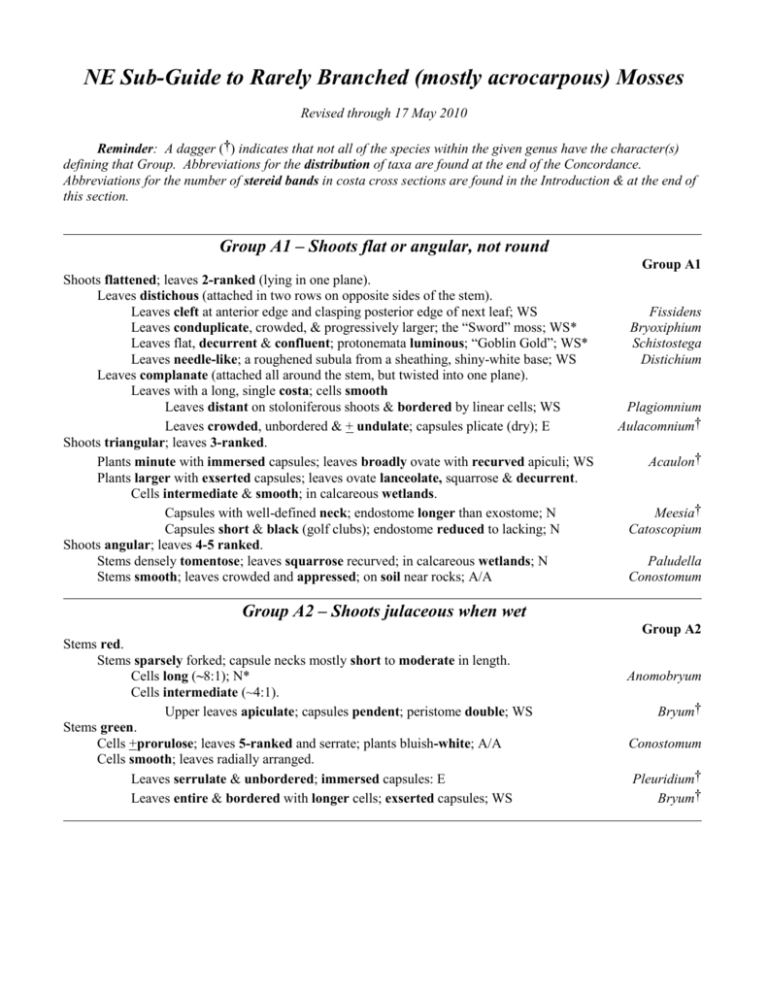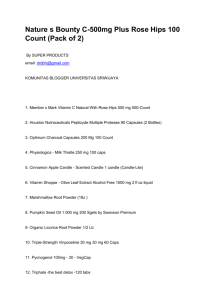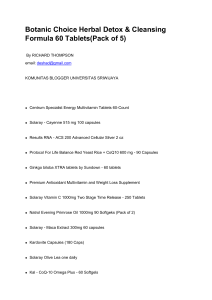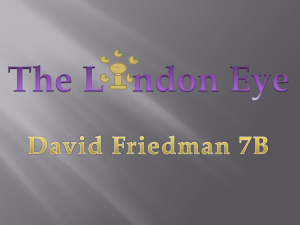MsWord
advertisement

NE Sub-Guide to Rarely Branched (mostly acrocarpous) Mosses Revised through 17 May 2010 Reminder: A dagger (†) indicates that not all of the species within the given genus have the character(s) defining that Group. Abbreviations for the distribution of taxa are found at the end of the Concordance. Abbreviations for the number of stereid bands in costa cross sections are found in the Introduction & at the end of this section. Group A1 – Shoots flat or angular, not round Group A1 Shoots flattened; leaves 2-ranked (lying in one plane). Leaves distichous (attached in two rows on opposite sides of the stem). Leaves cleft at anterior edge and clasping posterior edge of next leaf; WS Leaves conduplicate, crowded, & progressively larger; the “Sword” moss; WS* Leaves flat, decurrent & confluent; protonemata luminous; “Goblin Gold”; WS* Leaves needle-like; a roughened subula from a sheathing, shiny-white base; WS Leaves complanate (attached all around the stem, but twisted into one plane). Leaves with a long, single costa; cells smooth Leaves distant on stoloniferous shoots & bordered by linear cells; WS Leaves crowded, unbordered & + undulate; capsules plicate (dry); E Shoots triangular; leaves 3-ranked. Plants minute with immersed capsules; leaves broadly ovate with recurved apiculi; WS Plants larger with exserted capsules; leaves ovate lanceolate, squarrose & decurrent. Cells intermediate & smooth; in calcareous wetlands. Capsules with well-defined neck; endostome longer than exostome; N Capsules short & black (golf clubs); endostome reduced to lacking; N Shoots angular; leaves 4-5 ranked. Stems densely tomentose; leaves squarrose recurved; in calcareous wetlands; N Stems smooth; leaves crowded and appressed; on soil near rocks; A/A Fissidens Bryoxiphium Schistostega Distichium Plagiomnium Aulacomnium† Acaulon† Meesia† Catoscopium Paludella Conostomum Group A2 – Shoots julaceous when wet Group A2 Stems red. Stems sparsely forked; capsule necks mostly short to moderate in length. Cells long (~8:1); N* Cells intermediate (~4:1). Upper leaves apiculate; capsules pendent; peristome double; WS Stems green. Cells +prorulose; leaves 5-ranked and serrate; plants bluish-white; A/A Cells smooth; leaves radially arranged. Leaves serrulate & unbordered; immersed capsules: E Leaves entire & bordered with longer cells; exserted capsules; WS Anomobryum Bryum† Conostomum Pleuridium† Bryum† 2 Group A3 – Stems distinctly tomentose Group A3 Stems covered with pigmented (reddish to brownish) rhizoidal tomentum to near apex. Leaves squarrose-recurved & heart shaped; fens; N Leaves ovate to broadly elliptical. Rhizoidal initials in longitudinal rows; endostome fused into a dome; N Rhizoidal initials not in rows; endostome segments free; N* Leaves oblong-lanceolate to oblong-lingulate. Cells pleuripapillose; terminal cell long and smooth; brood bodies axillary; N* Cells unipapillose; terminal cell papillose; brood bodies terminal; WS Leaves lanceolate to subulate-setaceous; WS Stems covered with white-wooly tomentum. Leaves with green sheets (lamellae) on their surface; bogs; N* Leaves lacking lamellae; WS Paludella Cinclidium Rhizomnium† Zygodon† Aulacomnium† Dicranum Polytrichum† Dicranum Group A4 – Stems red Group A4 Plants julaceous. Stems occasionally forked; leaves ovate to ovate-lanceolate & concave. Leaves broadly obtuse to acute; costa ending subpercurrent; cells ~8:1; N* Leaves obtuse to acute; costa percurrent to excurrent; cells ~4:1; WS Plants with stems covered with pigmented (reddish to brownish) tomentum. Rhizoidal initials in longitudinal rows; endostome fused into a dome; N Rhizoidal initials not in rows; endostome segments free; N* Plants neither julaceous nor tomentose. Leaves bordered by elongated cells. Leaves distinctly toothed; cells smooth; leaves plane; WS Leaves entire; WS Leaves not bordered. Leaves serrulate +throughout; cells prorulose; WS Leaves +serrulate near the apex; cells smooth. Leaves subulate; alar cells inflated, thick-walled & reddish; N* Leaves not subulate; alar cells +undifferentiated; WS Anomobryum Bryum† Cinclidium Rhizomnium Mnium† Bryum† Philonotis† Blindia Pohlia† Group A5 – Leaves squarrose-recurved Group A5 Leaves squarrose-recurved when dry (or wet). Leaves 5-ranked & folded to appear heart shaped; stems densely tomentose; fens; N Leaves squarrose-recurved only when wet (+appressed when dry). Cells intermediate in length; WS Cells short. Leaves +bordered by longer, or shorter & thick-walled cells; 1*; WS Leaves unbordered; 2*; WS Paludella Dicranella† Tortula† Barbula† 3 Group A6 –Leaves falcate-secund Plants grayish; costa >1/2 leaf breadth with 3(4) cell layers; green striations on leaves; N* Plants green; leaves unistratose & lacking striations; costa usually <1/5 leaf breadth. Alar cells obvious; capsules rarely strumose; various habitats; 2*; WS Alar cells +undifferentiated; plants small, mostly <1cm; WS Group A6 Paraleucobryum† Dicranum† Dicranella† Group A7 –Leaves subulate / setaceous (8:1 or greater) Group A7 Plants small to minute (mostly <5 mm high) with +immersed capsules growing on bare soil, usually as winter annuals; the "pygmy ephemerals" as defined here. Setae straight; capsules immersed & cleistocarpous. Capsules pyriform with a conspicuous, stomatose neck; spores small; WS Bruchia† Capsules globose to ovoid, lacking a distinct neck. Calyptrae mitrate or cucullate; spores numerous & small; WS Pleuridium† Calyptrae rudimentary; spores few & large (>100µ); E Archidium† Plants larger with exserted capsules growing on various substrates. Leaves with bases distinctly incurved to expanded & clasping. Cells intermediate in length & prorulose/papillose; upper cells +bistratose; WS Bartramia† Cells intermediate in length & smooth. Capsules with distinct, very long necks; WS Trematodon† Capsules lacking a distinct neck. Plants larger; peristome single with forked teeth. Teeth divided to base, round & papillose; WS Ditrichum† Teeth divided to mid-point, flat & pitted-striolate; WS Dicranella† Cells short & smooth Upper cells +bistratose; capsules inclined, asymmetric & strumose; WS Oncophorus† Leaves with a broad, single costa (>1/3 the leaf width). Alar cells inflated & hyaline or colored (brownish to reddish). Costa 3(4) cell layers thick (middle & dorsal layers green & "striped"); N* Paraleucobryum Costa lacking the above unique characters. Inner basal cells pale, enlarged & extending up along the costa; N* Dicranodontium Alar cells +undifferentiated; capsules pyriform; WS Leptobryum Leaves lacking the above unique characteristics. Alar cells distinctly differentiated. Capsules obovoid to pyriform; on rocks. Capsules ribbed (dry); peristome teeth wide-flaring, +split & striolate; N Arctoa Capsules smooth (dry); peristome teeth erect, +entire & papillose; N* Blindia Capsules lacking any of the above unique characters; substrates various. Cells with cuticular ridges; peristome teeth +entire & papillose; N* Dicranoweisia Cells smooth; peristome teeth forked & pitted-striolate below; WS Dicranum† Alar cells +undifferentiated. Cells intermediate to long; peristome teeth usually present. Plants small (<2mm); leaves little altered (dry); on rocks; WS Seligeria† Cells short; annulus compound; peristome teeth mere stubs; WS* Brachydontium 4 Group A9 – Leaves with hair-points or awns Group A9 Plants minute (mostly <5 mm high) with +immersed capsules growing on bare soil, usually as winter annuals; the "pygmy ephemerals" as defined here. Leaves with reflexed tips; cells with single blunt papillae; WS* Acaulon† Plants growing on dung, animal remains, or other highly nitrogenous materials; the "dung mosses". Hypophysis greatly differentiated & colored; peristome teeth chambered; N, CP & SA Splachnum† Hypophysis narrowly pyriform & +urn-colored; peristome teeth not chambered; N Tetraplodon† Plants lacking any of the above unique characteristics. Leaves "fleshy" from crowded lamellae covering a very broad costa; WS Polytrichum† Leaves with distinct border. Cells short (+isodiametric); pleuripapillose or smooth; WS Desmatodon† Cells intermediate in length; smooth. Capsules pendent & pyriform; WS Bryum† Leaves with large, lax & hyaline basal cells contrasting with dense upper cells. Basal cells pale with brown, thickened cross walls; calyptrae campanulate; WS Encalypta† Basal cells thin-walled & non-pigmented throughout; calyptrae cucullate. Peristome of 32 twisted teeth on a high basal membrane; WS Tortula† Peristome of 32 +erect teeth on a low basal membrane; WS Desmatodon† Leaves lacking the above unique characteristics. Leaf cells mostly smooth. Plants in tufts on tree trunks & branches (rarely on rocks). Leaves crisped when dry; basal cells yellow, thick-walled; WC Ulota† Leaves not crisped when dry; basal cells undifferentiated; WS* Orthotrichum† Plants in tufts, cushions & mats on rocks. Calyptrae small, cucullate or mitrate. Capsules systylious; calyptrae short; in wetter habitats; WS Schistidium† Capsules not systylious; calyptrae to operculum; in dryer habitats; WS Grimmia† Plants on soil primarily. Cells intermediate in length; capsules pendent & pyriform; WS Bryum† Cells short (+isodiametric); capsules mostly erect & cylindrical; WS Desmatodon† Group A10 – Leaves with lamellae, ridges or filaments Group A10 Leaves with green, sheet-like lamellae. Leaves with a very broad costa covered by >20 lamellae. Lamellar apical cells papillose; capsules +terete. Leaves subtubulose; lamellar apical cells elliptic-pyriform; WS Leaves oblong lanceolate; lamellar apical cells +rounded; WS Lamellar apical cells smooth or ridged; capsules sharply 4-5 angled; WS Leaves with a narrow costa having <20 lamellae; WS Leaves with ridge-like lamellae on the back (dorsal side) of the costa; WS Leaves with fine, white, threadlike filaments in a tangled, cobwebby weft; N* Polytrichastrum Pogonatum Polytrichum Atrichum Dicranum† Saelania 5 Group A11 – Leaves undulate Leaves complanate (attached all around the stem but twisted into one plane); E Leaves with lamellae on the costa; WS Leaves lacking any of the above unique characteristics; N Group A11 Aulacomnium† Atrichum† Dicranum† Group A12 – Leaves involute Group A12 Leaf margins involute wet or dry. Leaf margins infolded / inflexed over photosynthetic lamellae or filaments; WS Leaf margins inrolled over laminae lacking lamellae or filaments. Leaf cells papillose. Capsules exserted & operculate; WS Capsules immersed to emergent, cleistocarpous; E Leaf margins involute when dry; plane to erect when wet; cells bulging on upper surface; E Polytrichum† Weissia Astomum Hyophila Group A13 – Leaves +all costa Leaves channeled & subtubulose; E Group A13 Leucobryum Group A14 – Leaves with a broad, single costa Group A14 Leaves bristle-like (setaceous) or with distinct hair-points. Leaves with costa of 3(4) cell layers (middle & dorsal layers green & “striped”); N* Leaves crowded at stem tips; reddish, axillary hairs common; WS Leaves lacking the above unique characteristics. Leaves with strongly differentiated alar cells (inflated & hyaline). Inner basal cells pale, enlarged & extending up along the costa; N* Leaves with alar cells little differentiated; WS Leaves oblong-lanceolate; capsules elongate, curved & with a conspicuous neck; N Paraleucobryum Leptobryum Dicranodontium Dicranella† Meesia† 6 Reminder: The costa in Groups A15 through A19 is long & single. Group A15– Leaves with bases distinctly incurved to expanded& clasping Group A15 Leaves subulate / setaceous (needle or bristle-like). Cells intermediate in length & prorulose/papillose; upper cells +bistratose; WS Bartramia† Cells intermediate in length & smooth. Capsules with distinct, very long necks; WS Trematodon Capsules lacking a distinct neck. Plants larger; peristome single with forked teeth. Teeth divided to base, round & papillose; WS Ditrichum† Teeth divided to mid-point, flat & pitted-striolate; WS Dicranella† Cells short & smooth; capsules inclined, asymmetric & strumose; WS Oncophorus† Leaves with lamellae or ridges on their laminae or costa. Leaves with a very broad costa covered by >20 lamellae. Leaves mostly unistratose; peristome present. Lamellar apical cells papillose; capsules +terete. Leaves subtubulose; lamellar apical cells elliptic-pyriform; WS Polytrichastrum Leaves oblong lanceolate; lamellar apical cells +rounded; WS Pogonatum Lamellar apical cells smooth or ridged; capsules sharply 4-5 angled; WS Polytrichum Leaves lacking any of the above unique characteristics; cells strongly bulging on upper surface; WS Timmia Group A16 – Leaves with long decurrencies Shoots angular in cross-section; leaves squarrose recurved; cells short & papillose; N Shoots terete (round in cross-section); capsules pyriform or pendulous. Leaves distinctly toothed +throughout. Marginal teeth paired; sterile stems +erect & round; WS Marginal teeth single; sterile stems prostrate & complanate; WS Leaves entire to +serrulate or +toothed at apex. Leaves predominantly broader near the middle; capsules pendent. Leaves commonly bordered; median cells <4:1; WS Leaves not bordered; median cells >4:1; WS Leaves predominantly broader at the base; setae very long; capsules +inclined; N Group A16 Paludella Mnium Plagiomnium Bryum† Pohlia† Meesia† 7 Group A17 – Leaves with a distinct group of hyaline cells Group A17 Note: hyaline cells may not be clearly distinct in very old leaves that have lost their chlorophyll. Hyaline cells at apex of leaves; plants whitish. Stems often forked or branched; cells papillose (simple & forked); capsules immersed; WS Hedwigia Stems rarely branched; leaves apiculate; capsules pendent; cells smooth; WS Bryum† Hyaline cells as marginal wedges broadest at the base of leaves. Leaves spreading & crenulate to entire; upper cells pleuripapillose; WS Tortella Hyaline cells in abruptly differentiated, +oval "windows" (cancellinae) in the lower 1/3 of leaves. Leaf margins revolute; peristome of 32 twisted teeth; 1*; WS Tortula† (Syntrichia) Hyaline, inflated & thin-walled cells across the lower 1/3 of leaves.# Leaves toothed above. Upper leaf cells densely pleuripapillose; capsules smooth; 2* Older leaves brick-red; stems lacking a hyalodermis; WS Bryoerythrophyllum Leaves revolute at least below; 1*. Leaves +rounded with short to long awns; cells 10-13µ; peristome present. Peristome of 32 twisted teeth on a high basal membrane; WS Tortula† Peristome of 32 +erect teeth on a low basal membrane; WS Desmatodon† Leaves +acute; cells 15-20µ; peristome none or rudimentary; WS Pottia† (Microbryum) Leaves lacking any of the above unique characteristics. Cross walls of basal cells thick & brown; calyptrae long campanulate; 1*; WS Encalypta† Cross walls of normal thickness; calyptrae cucullate. Stems with a hyalodermis; papillae usually bifid; 2* Stems lacking a central strand; WS Oxystegus Stems lacking a hyalodermis; papillae usually C-shaped; 1*. Peristome of 32 twisted teeth on a high basal membrane; WS Tortula† Peristome of 32 +erect teeth on a low basal membrane; WS Desmatodon† #: Note: Many taxa with short, papillose, medial cells possess basal cells that are somewhat differentiated, i.e., pale (translucent), less papillose, somewhat elongated and/or colored, especially near the insertion. The taxa in this Group A16 represent the extreme, strongly differentiated condition of a gradient while those taxa with the less differentiated basal cells are found in Group A23. 8 Group A18 – Leaves with a distinct marginal border Group A18 Leaves ciliate at the margins. Plants primarily protonemata; capsules inclined, ovoid & ventricose; WS* Buxbaumia Leaves with a border of elongate cells contrasting with shorter medial cells. Plants erect, rosulate-foliate & large; from horizontal, underground stems; WS Rhodobryum Plants strongly flattened; leaves twisted into one plane (complanate); WS Plagiomnium Plants with red stems; stems tomentose. Rhizoidal initials in longitudinal rows; endostome fused into a dome; N Cinclidium Rhizoidal initials not in rows; endostome segments free; N* Rhizomnium Plants lacking the above unique characteristics. Leaves with lamellae on the costa; WS Atrichum Leaves with paired teeth on margins; WS Mnium† Leaves with single teeth on margins. Leaves rounded-obtuse & apiculate; upper cells in oblique rows; N* Pseudobryum Leaves rounded-obtuse & apiculate; upper cells not in oblique rows; N* Plagiomnium Leaves acute to awned; cells not in oblique rows; capsules pendent & pyriform; WS Bryum† Leaves with entire margins. Leaf cells >3:1. Capsules pendent & pyriform; WS Bryum† Capsules erect; leaves rounded-obtuse; upper cells in oblique rows; N* Pseudobryum Leaf cells 1-2:1; A/A Cyrtomnium Leaves with margins differing in color and/or opacity from the medial laminae. Peristome (32) spirally twisted above a high basal membrane; WS Tortula† Peristome (16) obliquely slanted above a low basal membrane; WS Desmatodon† Group A19 – Leaves with distinct alar cells Stems tomentose; alar cells inflated, hyaline & +yellow-brown towards the margin; WS Stems not or indistinctly tomentose; alar cells not as above. Costa broad, >1/3 leaf width; alar cells inflated, & hyaline to brownish to reddish. Costa 3(4) cell layers thick (middle & dorsal layers green & “striped); N* Costa lacking the above unique characters. Inner basal cells pale, enlarged & extending up along the costa; N* Costa narrow, <1/3 leaf width. Alar cells enlarged to inflated & yellowish to brownish. Capsules obovoid to pyriform; on rocks; N* Capsules cylindrical; substrates various. Cells with cuticular ridges; peristome teeth +entire & papillose; N* Cells smooth; peristome teeth forked & pitted-striolate below; WS Alar cells sub-quadrate & pale; cells +thick-walled & often nodulose; WS Group A19 Dicranum Paraleucobryum Dicranodontium Blindia Dicranoweisia Dicranum Grimmia† 9 Group A20 – Leaves with costa extremely reduced to lacking Leaves in clusters of branches around a central stem & a network of green & hyaline cells; WS Leaves distichous, decurrent & confluent; protonemata luminous; “Goblin Gold”; WS* Leaves spinose serrate; protonemata persistent; cells smooth; pygmy ephemerals; WS Leaves lacking the above unique characters. Cells papillose; capsules exserted & valvate (4x); plants reddish-black; on rocks; N* Cells smooth. Capsules exserted with 4 large teeth; on undersides of rock overhangs; N Capsules sessile & gymnostomous; pygmy ephemerals; on soil; WS Group A20 Sphagnum Schistostega Ephemerum† Andreaea† Tetrodontium† Micromitrium Reminder: Definitions for cell length to breadth ratios are found in the Introduction, the Overview & at the end of this section. Group A21 – Cells long (>5:1) & smooth Leaves little altered (dry); cell walls not thickened; capsules inclined to pendulous; WS Group A21 Pohlia† Group A22 – Cells intermediate (2-5:1) & distinctly papillose Leaves ovate & abruptly narrowed to a short acumen; papillae simple; W & VT Leaves linear-lanceolate to subulate from an erect base; papillae simple; WS Group A22 Philonotis† Bartramia† Group A23 – Cells intermediate (2-5:1) & distinctly prorulose Leaves julaceous and 5-ranked; peristome teeth fused at tip; A/A Leaves and peristome teeth otherwise. Setae straight; capsules asymmetric & furrowed; peristome teeth lanceolate. Leaves with bistratose margins &/or lamina; mesic habitats; WS Leaves unistratose; hydric habitats; WS Setae short, capsules immersed Leaves +linear-lanceolate & +spinulose above; protonemata persistent; WS Leaves +subulate & serrulate above; protonemata ephemeral; WS Group A23 Conostomum Bartramia† Philonotis† Ephemerum† Bruchia† 10 Group A24 – Cells intermediate & smooth (or indistinctly ornamented*) Group A24 Leaves predominantly broader near or above the middle (+oblong or obovate). Plants small, winter annuals on soil. Capsules clearly exserted. Costa strong; protonemata ephemeral; peristome lacking; WS Physcomitrium Costa weak; protonemata persistent; peristome present; WS* Discelium Capsules +immersed & +pyriform. Leaves +concave-obovate & serrulate; capsules operculate; WS Physcomitrium Leaves +concave-ovate & entire; capsules cleistocarpous; WS Bruchia† Plants otherwise. Leaves commonly bordered by linear cells; capsules pyriform & pendent; WS Bryum Leaves unbordered. Medial cells smooth & >5:1 (linear rhomboidal); capsules pendent; WS Pohlia† Medial cells smooth & <4:1; capsules inclined to erect. Peristome of 4 massive teeth; plants bud-like; costa weak; on rocks; N Tetrodontium Peristome of 16 teeth; costa strong; on soil. Capsules with well-differentiated necks; calyptrae mitrate; N* Tayloria Capsules lacking a distinctive neck; calyptrae inflated cucullate. Capsules inclined & asymmetric; WS Funaria Peristome lacking; capsules erect & symmetric; calyptrae mitrate; WS Physcomitrium Leaves predominantly broader near the base (+lanceolate). Plants small, winter annuals on soil; capsules +immersed & cleistocarpous; WS Bruchia† Plants otherwise; capsules exserted & peristomate. Leaves 3-ranked; setae very long; plants of calcareous wetlands. Capsules with well-defined neck; endostome longer than exostome; N Meesia Capsules short & black (golf clubs); endostome reduced to lacking; N Catoscopium Leaves +subulate / setaceous. Capsules ovoid; plants minute to very small; on calcareous rocks; WS (N) Seligeria Capsules long cylindric; peristome teeth round, fully split & papillose; WS Ditrichum Capsules +oblong, often curved; peristome teeth flat, split 1/2 & pitted; WS Dicranella Leaves with expanded, sheathing leaf bases; WS Dicranella Leaves lacking any of the above unique characteristics. Plants on calcareous rocks & small (<2mm); setae cygneous (wet); N Seligeria campylopoda Plants of calcareous wetlands; setae very long; peristome double; N Meesia Plants of Cu or S rich soils; setae lateral; peristome endostome only; N* Mielichhoferia Plants of disturbed soil; setae terminal; peristome single; WS Ditrichum *: bulging, mammillose, indistinctly papillose (i.e. low papillae) or slightly prorulose. 11 Group A25 – Cells short (<2:1) & distinctly papillose Group A25 Timmia† Leaves with expanded, sheathing bases; cells strongly bulging on upper surface; WS Leaves distinctly toothed in the upper half. Cells unipapillose or mammillose; ventral stereid band weak or lacking. Leaves +narrow; cells coarsely papillose; capsules furrowed; N Cynodontium† Leaves lacking the above unique characteristics. Cells pleuripapillose. Papillae forked; basal cells with brown cross-walls; calyptrae long-cylindric; WS Encalypta Papillae C-shaped. Basal cells with brown cross-walls; calyptrae long-cylindric; 1*; WS Encalypta Basal cell walls uncolored; calyptrae cucullate. Peristome teeth long & twisted; 2*; WS Barbula† Peristome teeth short & erect; 1*; WS Desmatodon† Papillae conical. Cells with 4-7 papillae; Stems repeatedly forked; capsules elongate & urn-shaped; 2*; WS Amphidium Stems sparsely forked; capsules +pyriform; 1* or lacking; WS* Zygodon Cells with 1-4 papillae. Costa with two stereid bands. Leaf margins revolute on both sides; peristome present. Papillae crowded; basal cells hyaline; peristome twisted; WS Barbula† Papillae scattered; basal cells green; peristome +oblique; WS Didymodon† Leaf margins revolute on one side only; peristome lacking; WS Hymenostylium Leaf margins plane; peristome lacking; WS Gymnostomum Costa with one stereid band; peristome lacking. Sporophytes lateral; stem rounded-triangular; WS Anoectangium Sporophytes terminal; stem round; WS Gymnostomum Costa lacking stereid bands; peristome present. Basal marginal cells with thickened cross-walls; WS Ulota† Basal marginal cells +undifferentiated; WS Orthotrichum† Cells unipapillose. Leaves serrulate at apex; stems tomentose; gemmae on stem extensions; WS Aulacomnium† Leaves entire. Capsules exserted; peristome of 32 twisted teeth; plants on soil & rocks; 2*; WS Barbula† Capsules +emergent & valvate (4x); blackish plants on rocks; 0*; N* Andreaea† Capsules +immersed with 16 +reflexed teeth; plants on trees & rocks; 0*. Basal marginal cells with thickened cross-walls; WS Ulota† Basal marginal cells +undifferentiated; WS Orthotrichum† 12 Group A26 – Cells short (<2:1) & smooth (or indistinctly ornamented*) Group A26 Leaves +oblong-spathulate (broad in the middle & even broader above). Leaf margins inrolled when dry (erect or plane when wet); cells bulging on upper surface; E Hyophila Leaf margins usually revolute, at least in part; cells flat. Leaves +bordered with longer cells; peristome teeth short & erect; 1*; WS Desmatodon† Leaves +bordered with shorter cells; peristome teeth long & twisted; 1*; WS Tortula† Leaves unbordered. Propagula axillary; peristome of 32 spirally twisted teeth; 2*; WS Barbula† Leaf margins plane; cells flat & large (>15µ); peristome none or rudimentary; 1*; WS Pottia† Leaves +oblong-lingulate (tongue shaped)or oblong-ligulate (strap shaped); E & BC Diphyscium Leaves +ovate (broadest in lower third; egg-shaped) & revolute; peristome of 32 teeth; 2*; WS Barbula† Leaves ovate-lanceolate to lanceolate (broadest near the base; lance-shaped). Leaves with expanded, sheathing leaf bases. Cells bulging on upper surface; capsules symmetric & oblong-ovoid; WS Timmia Cells smooth; capsules asymmetric & strumose (goiter-like swelling); WS Oncophorus Leaves with paired teeth on bistratose margins. Margins revolute below; cells with cuticular ridges; perichaetia terminal; N* Plagiopus Leaves bistratose, at least in part; Leaves curved to crisped (dry); cells bulging or flat. Calyptrae mitrate, lobed & plicate; 2*; WS Ptychomitrium Leaves lacking any of the above unique characters. Continued below at left margin 13 Continued from Group A26 above Leaves lacking the above unique characteristics. Capsules split along 4 sutures; plants saxicolous & blackish; N* Andreaea† Capsules with 4, massive teeth; leaves pellucid; terminal gemmae cups; WS Tetraphis Capsules with 8, 16 or 32 lanceolate teeth. Plants in tufts on tree trunks (rarely on rocks); diplolepideous. Leaves crisped when dry; basal cells yellow, thick-walled; WC Ulota† Leaves not crisped when dry; basal cells +undifferentiated; WS* Orthotrichum† Plants in tufts, cushions or mats on rocks. Peristomes diplolepideous. Basal cells very thick-walled, yellow & radiating from costa; WS Ulota† Basal cells +thick-walled, neither yellow & nor radiating; WS Orthotrichum† Peristomes haplolepideous. Capsules systylious; calyptrae short; in wetter habitats; WS Schistidium† Capsules not systylious; calyptrae longer; in dryer habitats; WS Grimmia† Plants on soil primarily. Setae cygneous; capsules yellowish & smooth; calyptrae mitrate; N* Campylostelium Setae bent at capsule base; capsules strumose & purple-red; leaves revolute throughout & serrate apically; upper cells +square; WS Ceratodon Setae straight. Capsules ribbed; in crevices of cliffs & boulders. Peristome teeth divided to half their length; N Cynodontium† Peristome teeth undivided; E Rhabdoweisia Capsules smooth (or wrinkled when dry); calyptrae cucullate. Setae very long; capsules inclined; peristome double; in fens; N Meesia Setae shorter; capsules erect; peristome single; on mineral soils. Basal cells hyaline; peristome teeth twisted; WS Barbula† Basal cells green; peristome teeth +oblique; WS Didymodon† *: bulging, mammillose (cells both bulging & papillose) or indistinctly papillose, i.e. low papillae Cell length to breadth ratio: Long cells: >5:1; commonly termed linear. Intermediate cells: 2-5:1; commonly termed elongated, rectangular, hexagonal or rhomboidal. Short cells: <2:1; commonly termed isodiametric, quadrate, rounded-quadrate or sub-quadrate. Cells = medial, laminal cells; cells ~2/3 of the way from insertion to apex, midway between the costa & the margin. Number of stereid bands evident in costa cross-sections: 2* = costa with two stereid bands 1* = costa with one stereid band 0* = costa lacking stereid bands, i.e., +homogeneous End.







